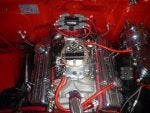Gday,
I have another problem ( they never seem to end )
My 350 small block motor regularly stalls when it is idling and in gear.
Its a new motor and only has 1700 KLM on the clock.
It does not always do it but after the engine warms up it starts to regularly stall when I am at the lights or stopped at a intersection.
So basically when the engine heats up and I have the brakes on and its in gear it wont idle it splutters and stalls.
If I leave it idling and its not in gear it runs fine and does not miss a beat.
If its idling and not in gear and the brakes are on it runs fine it only cuts out when in gear and idling.
Its runs great once I start to drive but it wont idle when warn and in gear.
I have sprayed carby cleaner all round the carby and intake manifold whist the motor is running and I cant find any vacuum leaks.
I have checked all vacuum hose and they are correct vacuum hose and have no leaks, I have checked the power brake booster and check valve they all seem fine.
The turbo 350 has been rebuilt and has a new modulator on it.
The only way I can drive it is to put the idling up to 900 RPM but it still stall from time to time at 900 rpm
The motor idles with a vacuum of 15 so I am starting to think that's its not a Vacuum problem but I could be wrong.
It is also hard to start after the engine is warm I have to pump the gas pedal a few time for it to start but it starts easy when its cold.
The fuel pressure is 6 psi and the fuel bowls are adjusted as per the carby specs.
I have adjust the air mixture screws so many times but nothing seems to make any difference at all.
Has any one got any ideas of what could be the problem.
I would appreciate your input as I am desperate to fix this ongoing problem.
see pic of motor and set up.
Thank you
Maca
![]()
I have another problem ( they never seem to end )
My 350 small block motor regularly stalls when it is idling and in gear.
Its a new motor and only has 1700 KLM on the clock.
It does not always do it but after the engine warms up it starts to regularly stall when I am at the lights or stopped at a intersection.
So basically when the engine heats up and I have the brakes on and its in gear it wont idle it splutters and stalls.
If I leave it idling and its not in gear it runs fine and does not miss a beat.
If its idling and not in gear and the brakes are on it runs fine it only cuts out when in gear and idling.
Its runs great once I start to drive but it wont idle when warn and in gear.
I have sprayed carby cleaner all round the carby and intake manifold whist the motor is running and I cant find any vacuum leaks.
I have checked all vacuum hose and they are correct vacuum hose and have no leaks, I have checked the power brake booster and check valve they all seem fine.
The turbo 350 has been rebuilt and has a new modulator on it.
The only way I can drive it is to put the idling up to 900 RPM but it still stall from time to time at 900 rpm
The motor idles with a vacuum of 15 so I am starting to think that's its not a Vacuum problem but I could be wrong.
It is also hard to start after the engine is warm I have to pump the gas pedal a few time for it to start but it starts easy when its cold.
The fuel pressure is 6 psi and the fuel bowls are adjusted as per the carby specs.
I have adjust the air mixture screws so many times but nothing seems to make any difference at all.
Has any one got any ideas of what could be the problem.
I would appreciate your input as I am desperate to fix this ongoing problem.
see pic of motor and set up.
Thank you
Maca





